
First
and Only Weekly Online Fanzine Devoted to the Life & Works of Edgar
Rice Burroughs
Since
1996 ~ Over 10,000 Web Pages in Archive
Volume
2006

First
and Only Weekly Online Fanzine Devoted to the Life & Works of Edgar
Rice Burroughs
Since
1996 ~ Over 10,000 Web Pages in Archive
Volume
2006
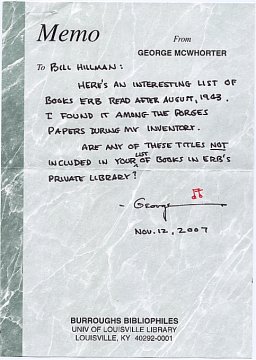 |
EDGAR RICE BURROUGHS FROM 1943: Part V An Addendum to the ERB Library Project www.ERBzine.com/dan Found by George McWhorter
"A few of the books I read from Aug 1943
|
| Thomas Gann (May 13, 1867 - February 24, 1938) |
| Mystery Cities of the Maya: Exploration and Adventure in Lubaantun
and Belize ~ Scribners, N.Y. 1925
Title Page: Mystery Cities Exploration and Adventure in Lubaantum Begins with Belize, capital of British Honduras, Central America -- Lubaantum evidently a ruined city of the Mayas -- three periods of occupation. A classic on the Atlantis myth, this is a rollicking archeological adventure in the Central American jungle by one of the last gung-ho English explorers in the tradition of Livingston. Gann battles pirates along Belize's coasts and excavates a strange lost city amid waves of scorpions Fly leaf dedication: "To Ed From Emma December 25, 1926 Tarzan Again!" 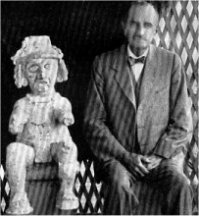 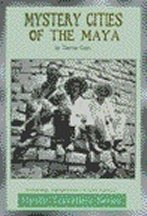
First published in 1925, Mystery Cities of the Maya is a classic in Central American archaeology-adventure. Gann was close friends with Mike Mitchell-Hedges, the British adventurer who discovered the famous crystal skull with his adopted daughter Sammy and Lady Richmond Brown, their benefactress. Gann battles pirates along Belizes coast and goes upriver with Mitchell-Hedges to the site of Lubaantun where they excavate a strange lost city where the crystal skull was discovered. Lubaantun is a unique city in the Mayan world as it is built out of precisely carved blocks of stone without the usual plaster-cement facing. Lubaantun contained several large pyramids partially destroyed by earthquakes and a large amount of artifacts. Gann shared Mitchell-Hedges belief in Atlantis and lost civilizations (pre-Mayan) in Central America and the Caribbean. Lots of good photos, maps and diagrams from the 1920s. OTHER
The History of the Maya from the Earliest Times to the Present
Day by Thomas William Francis Gann, Sir John Eric Sidney Thompson
~ Charles Scibner's Sons, New York - 1931 -264p
BIO
|
| Thomas Bellows Wyman |
Two volumes: The Genealogies and Estates of Charlestown in the County
of Middlesex and Commonwealth of Massachusetts - 1629-1818 ~
Boston, David Clapp and Son 1879

Reprinted later: Somersworth: New England History Press. 1982. Reprint. Combines the two volume 1879 edition into one thick volume., 1060., Map in pocket at rear. Previously described in the main ERB Library Project series: Shelf w4 Charlestown was established about 1630 at the beginning of the Great Migration, and was annexed to Boston in 1874. It is situated in Middlesex County which was created in 1643 when Massachusetts Bay Colony was divided into four shires. Originally Charlestown also included Burlingt on, Malden, Somerville, Stoneham, Wilmington, Winchester, and Woburn, and p arts of Arlington, Cambridge, Medford, and Reading. Its extant records begin in the mid-1630s. This is truly a phenomenal genealogical collection. |
| Henry M. Stanley |
In Darkest Africa (2 volumes) ~ London, George Newnes; 1899;
2 volumes with 6 maps in volume 1, including one foldout map.
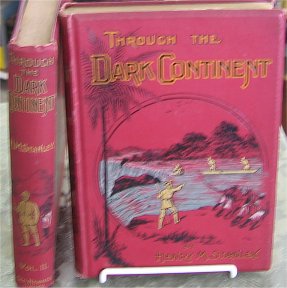 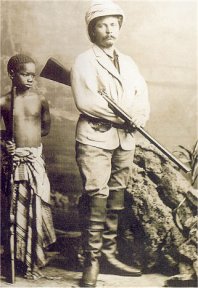 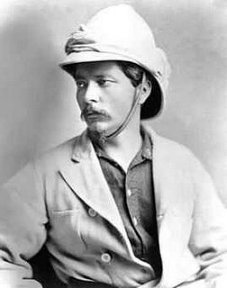 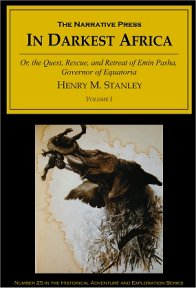
Book Description adapted from the Narrative Press site At the end of the 19th century the interior of the African continent was largely unknown to the American and European public. Accounts of expeditions to the Dark Continent thrilled readers who longed to follow in the footsteps of the great explorers. One of the greatest was Henry M. Stanley. He had already achieved fame from his quest to find Dr. Livingstone, and in 1888 he led an expedition to come to the aid of Mehmed Emin Pasha. In Darkest Africa is his account of what happened. The Pasha was born Edward Schnitzler in Germany, had assumed the title "Emin Effendi Hakim" (the faithful physician) while employed as a doctor in Khartoum, and had later been appointed the local governor in the southern Sudan. He had been forced from Khartoum into retreat to the shores of Lake Albert by a revolt led by the Islamic holy man known as the "Mahdi." Stanley had met Emin on an earlier expedition, and was felt to be the logical choice to lead this new campaign. Volume One of this two-volume set details the political events that lead up to the revolt, and the progress of Stanley from the mouth of the Congo River to Lake Albert (in present day Uganda) a journey of over 1,400 miles. They traveled by steamers (one being the Stanley, of course), and they had their own steel frame "canoe," which could be broken down into sections for portage. Legends about dwarves living in the forests of central Africa had been widely circulated, and Stanley was certain he had met them in the tribe of the Pygmies near Fort Bodo, one of his most exciting encounters. He also provides descriptions of the wide variety of native peoples, villages and terrain through which he traveled. Marching through the forests he writes: …sections of the primeval forest separated each village; along the track were pitfalls for some kind of large forest game, or bow-traps fixed for small animals, such as rabbits, squirrels, rats, small monkeys. In the neighbourhood of each village the skewers were plentiful in the ground,…The main approaches to the many villages were studded with these poisoned skewers, which made every one except the booted whites tread most gingerly. Nor could the Europeans be altogether indifferent, for slightly leaning, the skewer was quite capable of piercing the thickest boot-leather and burying the splinters of its head deep in the foot… Stanley and his men had to contend with disease, desertions, and lack of food, as well as attacks upon them by hostile natives. In an incident that later led to questions about Stanley's judgment, he left a detachment of men at Yambuya to await the arrival of a promised 600 porters with orders for them to rejoin the main party. They never did, and he is careful to document his version of the affair in this book. Volume Two chronicles Stanley's reaching the Emin Pasha and finally persuading him to abandon Lake Albert in 1889. Again he is zealous in his reporting, including accounts of a personal nature such as his attack of inflammation of the stomach, as well as those of greater interest to the general reader. Again they contend with disasters: at one point they must feed 130 people on a thin butter and milk broth for days on end, at another they fend off a surprise ambush. In all, 1,500 people made the journey that ended in Bagamoyo (present day Tanzania). They travelled through the legendary Ruwenzori range (Uganda), which few Europeans had seen, and which had been the subject of much speculation by everyone from Greco-Roman to medieval Arab scholars: …The fables that have been woven about it; its relation to the dear old Nile…the Nile of the Pharaohs, of Joseph, Moses, and the Prophets; its being the source whence so many springs of the Nile issue -- its being the creator of the "Sea of Darkness," Lake Albert Edward, from whose bosom the Semliki -- Nile to the West, and the infant Kafur to the East -- emerge…the very mountain before whose shrine Alexander and Caesar would have worshipped -- if the poets may be believed; its rare appearance out of the night-black clouds; its sudden and mysterious apparition…its quaint title -- the Mountains of the Moon, so often sought in vain; its massive and rugged grandeur, and immense altitude: all these explain why Ruwenzori demands more than a brief notice. Stanley verified that the Semliki River linked Lake Edward to Lake Albert, which was big news to those interested in the sources of the Nile. It took them sixteen days to cross the Semliki valley region: During that time we had ten separate rainfalls, several of them lasting over nine hours, while it thundered daily. Besides this, when we issued out of the forest, and clung to the grassy foot of the range, at a few hundred feet of altitude above it, we observed that, as far as we could see, the forest extended unbroken, except by the numerous banana plantations…No winds could cool this portion of the valley, or waft the vapours away and clear the atmosphere from an entire corner of the compass, owing to the extent and great height of Ruwenzori… This is an extremely important book for all those interested
in the history of Africa, both for its descriptions of indigenous peoples
and terrain and for what it reveals about the imperialist attitudes that
shaped the course of events. And not to be entirely irreverent, but if
you visit Stanley's grave site in England, you'll notice that his is a
giant stone, surrounded, it seems, by pygmy stones. We think that Sir Henry
Morton Stanley would find this a fitting tribute to his stature.
Biography Adapted from the Narrative Press Site 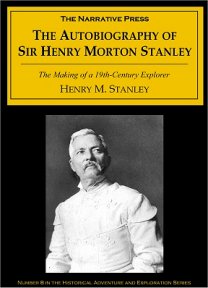 Henry
Morton Stanley is one of the most famous 19th century British explorers;
he is best known for finding Dr. Livingstone and for his subsequent exploration
in Africa and establishment of the Congo Free State. However, most people
are not familiar with this illustrious man's early life or his private
thoughts. As he stated in a letter to his wife (who edited the book): Henry
Morton Stanley is one of the most famous 19th century British explorers;
he is best known for finding Dr. Livingstone and for his subsequent exploration
in Africa and establishment of the Congo Free State. However, most people
are not familiar with this illustrious man's early life or his private
thoughts. As he stated in a letter to his wife (who edited the book):
Were I suddenly to be called away, how little, after all, the world would know of me! My African life has been fairly described, but only as it affected those whom I served, or those who might be concerned. The inner existence, the me, what does anybody know of? Stanley's purpose in writing the autobiography was to inspire young boys growing up under such difficult circumstances as he himself experienced. Stanley's early life was painful and bleak -- an illegitimate child, he was sent to a workhouse at a young age because his family found him too much of a burden. There he was beaten and abused, but nevertheless received a fairly good education. While the circumstances of his childhood are certainly sad, it is amusing to hear this famous explorer's dramatic flair for self-pity: "...I was not sent into the world to be happy, nor to search for happiness." The first nine chapters are dedicated to Stanley's early life, and help to illuminate the events of his later distinguished career. He escaped the workhouse, traveled around the U.K. a bit, and then went off to sea and became a soldier in America. In the second part of the book, Stanley's wife edits together the threads of narrative contained in his later journals. In these chapters we get a more immediate account of the events as they happened than we get in his other books. Some of these stories are brief but telling, and his wife fills them out with notes afterwards: "Judge drunk; tried to kill his wife with hatchet; attempted three times. -- I held him down all night. Next morning, exhausted; lighted a cigar in parlour; wife came down -- insulted and raved at me for smoking in her house!" Other anecdotes are more detailed, as when Stanley tells of the Indian wars in Western America or when he describes his time on the Greek island of Syra. Regardless of how he recorded it in journals, Stanley always found adventure in his many years of wandering. For those who know something of Stanley's other work (such as In Darkest Africa, also available from The Narrative Press), his autobiography will be fascinating, and provides much different perspective from what we already know. Find out what was really going on in his mind as he journeyed through Africa in search of Dr. Livingstone: Fatal Africa! One after another, travellers drop away. It is such a huge continent, and each of its secrets is environed by so many difficulties, -- the torrid heat, the miasma exhaled from the soil, the noisome vapours enveloping every path, the giant cane-grass suffocating the wayfarer, the rabid fury of the native guarding every entrance and exit, the unspeakable misery of the life within the wild continent, the utter absence of every comfort, the bitterness which each day heaps upon the poor white man's head, in that land of blackness... |
| Carl E. Akeley | |||||
| In Brightest Africa ~ 1920/1923 - Garden City Publishing 267p
A hunter's account of Tanzania, Kenya and Zaire. This is the only book written solely by Akeley, an early and prominent member of the Boone & Crockett Club. His taxidermy work and sculptures are featured items in the New York Museum of Natural History. Dedicated to the memory of Theodore Roosevelt. Autographed "Edgar Rice Burroughs Tarzana Ranch Nov. 20, 1923" 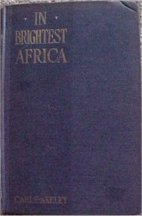 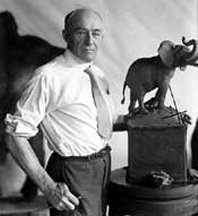 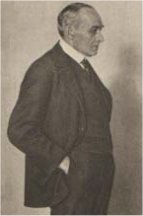
BIOGRAPHY
More ERBzine Refs: ERB Library Shelf A1 http://www.erbzine.com/dan/a1.html Vern Coriell Collection http://www.erbzine.com/mag16/1685h.html Web Refs
|
| Archie Butts |
| The Letters of Archie Butts (Personal Aide to President Roosevelt)
Doubleday Page & Co. 1924 N.Y. Fly leaf: "Merry Christmas to Papa with a world of love from Joan December 25, 1924" (ERB expressed constant admiration for Teddy Roosevelt) No notations in these books at all -- ALSO: Taft and Roosevelt: 2 volumes: the intimate letters of Archie Butt, military aide ~ NY, Doubleday Doran, 1930. 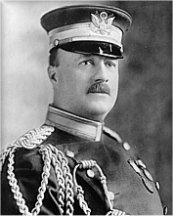
In 1912, there was a big rift in the Republican Party with President Taft and Theodore Roosevelt vying for control. Unless the rift was healed, the Republican vote in the 1912 election would be split and a Democrat would be elected. Many felt that only "Archie" Butts could heal the rift. The healing would have to wait as Archie was on leave in England but was scheduled to return home soon...on the Titanic. On April 15, 1912, Major Butts, along with over 1500 other passengers perished when the unsinkable liner Titanic sank in the North Atlantic on her maiden voyage. President Woodrow Wilson was elected President in the 1912 election. This photo is regarded as the last taken of the Titanic as she sailed from Southhamption with Major Butts on board for that fateful voyage.
More ERBzine Refs ERB Personal Library: Shelf B6 Web Refs
|
| Caspar Whitney |
| Jungle Trails and Jungle People: Travel, Adventures and Observations
in the Far East.
New York Charles Scribner's Sons 1905 OR Harper & Bros. New York & London 310 & 4 pages publisher's adverts, illustrated with 32 photographic plates including frontispiece Fly leaf: "Edgar Rice Burroughs (sig) Tarzana Ranch March 1922"
Whitney writes of early travel and adventures in the jungles of Siam, Sumatra, Malay, India and Burma with descriptions of the Klawngs of Siam, Phra Ram, hunting with the Burmese Karens, human tree-dwellers, the lost Seladang of Noa Anak, camping in the jungles, the Sakai and their poisonous darts, Malayan dancers, women, and villages, tiger drives in India and much more. Included are hunting adventures along with the travel but it is mainly a travel book. New York Times Revew: October 21, 1904 Others
|
| John L. Stoddard |
| Of Historical Interest: From ERB's Past (not on ERB's list)
See the Burroughs Online Biography Stoddard's Lectures ~ Boston, Balch Brothers, 1907; 10 volumes + 4 supplementary volumes. All edges gilt, gilt decoration to spines and covers. John L. Stoddard was one of the greatest American travellers of the late 19th century. In 1898, his popular lectures were published in ten volumes each containing unbiased stories and hundreds of his photographs. Their popularity was so great, multiple printings were made (up into the 1920s) and sold by door-to-door salesmen as if they were encyclopedias. In a way, Stoddard's Lectures were an encyclopedic source of stories and images of countries he visited, giving Americans a glimpse of the world beyond the oceans. 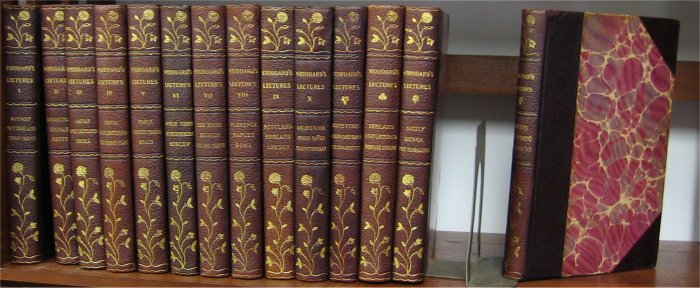 |
1000 Years of Russian History (parts of)
ALPHABETICAL SORT
ANTHONY, Irvin Revolt at Sea
ASBURY, Herbert The Gangs of New York
ASHTON-WOLFE, H. Warped in the Making
BALDWIN, Hanson W. The Caissons Roll
BARTON, George Thrilling Triumphs of Crime Detection
BASSETT, John Spencer Ph D A Short History of the U S - 1492-1938
BLEACKLEY, (Duchess of Hamilton & Duchess of Argyll) The Story of A Beautiful Duchess
BROCK, H. I. Meddlers "Too stupid. Couldn't read."
BRUST, Inspector, Scotland Yard I Guarded Kings
BUCHAN, John Book of Escapes and Hurried Journeys
CAREY, Arthur A. Memoirs of a Murder Man Formerly Head of NY City Homicide Squad
CELLENI, Benvenuto Autobiography of Celleni
CLARKE, Donald Henderson In the Reign of Rothstein
COOPER, Courtney Riley Ten Thousand Public Enemies
COWARD, Noel Present Indicative
DOWER, Kenneth Gandar The Spotted Lion "Swell"
Encyclopedia Britannica
FARAGO, Ladislas The Axis Grand Strategy "Read 162 pgs only. Repetitious"
FARREN, Henry Desmond Sabotage
FINGER, Charles J. Bushrangers
FRENCH, Joseph Lewis Gray Shadows
HEADLAND, Isaac Taylor Court Life in China Professor in the Peking Univ.
HEDIN, Sven The Flight of Big Horse
HOUGH, Emerson The Passing of the Frontier "Read 61 pages. Too dry"
In the Clutch of Circumstance by an ex-convict
JOHNSON, Clifford Pirate Junk (Five months captivity with Manchurian bandits)
KAVANAGH, Judge Marcus You be the Judge
LAWES, Warden Lewis E. Cell 202 Sing Sing
LLOYD, Harold American Comedy: Autobiography Swell
LOBAGOLA, Lobagola Autobiography of Bata Kindai Amzoga Ibn LoBagola, a Negro.
He says he learned to lie after coming to civilization.
He seems to have been an apt pupil.
LONGSTRETH, T.Morris & Henry Vernon Murder at Belly Butte
MAY, Luke S. Crime's Nemesis
OPPENHEIM, E. Phillips Pool of Memory (Autobiography)
PAINE, Ralph D. The Old Merchant Marine
PEARSON, Edmund Instigation of the Devil
PEARSON, Edmund More Studies in Murder
PLATT, R.H. Jr. Mr. Archer, USA
"Archer was presumably 'Capt Macklin' of Richard Harding Davis's story."
RASHLEIGH, Ralph Adventures of an Outlaw: Memoirs of Ralph Rashleigh
Reminiscences of a Ranger
Spanish Inquisition (parts of)
TASKER, Robert Joyce (A convict) Grimhaven (part of) "Tiresome"
Ten Bad Men (?)
The Terrible Borgias (?)
THURSTON, Lorrin A. The Foreign Language Schools Nov 8 1920
VAN CISE, Philip S. Fighting the Underworld
VERRILL, A. Hyatt Lost Treasure
BERNSTORFF Memoirs of Count Von Bernstorff
VON KRAFFT-EBING, Richard M.D. Psychopathia Sexualis
VOLLMER, August and Alfred E. Parker Crime, Crooks, and Cops
WEEKS, Patrick H. MD (Prison physician) Big House of Mystgery
WENSLEY, F. P. Forty Years of Scotland Yard
WOLSELEY, Field-Marshal Viscount Story of a Soldier's Life (Vol. 1)
WREN, Lassiter Masterstrokes of Crime Detection
RESEARCH
Burroughs Library of Books on His Shelves
(Evidently Used for Research) (A few listed below)AKELEY, Carl E. In Brightest Africa
Autographed "Edgar Rice Burroughs Tarzana Ranch Nov. 20, 1923"BUTTS, Archie The Letters of Archie Butts (Personal Aide to President Roosevelt) Doubleday Page & Co. 1924 N.Y.
Fly leaf: "Merry Christmas to Papa with a world of love from Joan December 25, 1924"
(ERB expressed constant admiration for Teddy Roosevelt) No notations in these books at allGANN, Thomas Mystery Cities Hardcover, Scribners, N.Y. 1925
Title Page: Mystery Cities Exploration and Adventure in Lubaantum Begins with Belize, capital of British Honduras, Central America -- Lubaantum evidently a ruined city of the Mayas -- three periods of occupation --
Fly leaf dedication: "To Ed From Emma December 25, 1926 Tarzan Again!"STANLEY, Henry M. In Darkest Africa (2 volumes)
WHITNEY, Caspar Jungle Trails and Jungle People Harper & Bros. New York & London
Fly leaf: "Edgar Rice Burroughs (sig) Tarzana Ranch March 1922"WYMAN, Thomas Bellows The Genealogies and Estates of Charlestown in the County of Middlesex and Commonwealth of Massachusetts
1629-1818 (Two Volumes) (Boston, David Clapp and Son 1879)
ORIGINAL SORT AS TYPED BY ERBEdmund Lester Pearson
More Studies in MurderF. P. Wensley
Forty Years of Scotland Yard:
The Record of a Lifetime's Service in the Criminal Investigation DepartmentSpanish Inquisition (parts of)
1000 Years of Russian History (parts of)
Encyclopedia Britannica
Ten Bad Men (?)
Benvenuto Celleni
Autobiography of Benvenuto Celleni: A Florentine Artist
Containing a Variety of Information Respecting the Arts and the History of the Sixteenth CenturyBorgias ~ Gregorovius ~ Sabatini
The Terrible BorgiasEdmund Lester Pearson
Instigation of the DevilWarden Lewis E. Lawes
Cell 202 Sing SingSven Hedin
The Flight of Big Horse - The Trail of War in Central Asia.H. Ashton-Wolfe
Warped in the Making: Crimes of Love and HateGeorge Barton
Thrilling Triumphs of Crime DetectionHerbert Asbury
The Gangs of New YorkArthur A. Carey
Memoirs of a Murder Man by Arthur A. Carey late deputy inspector in charge of the Homicide bureau, New York city Police department, in collaboration with Howard McLellan.Judge Marcus Kavanagh
You be the JudgeCourtney Riley Cooper
Ten Thousand Public EnemiesJoseph Lewis French
Gray ShadowsDonald Henderson Clarke
In the Reign of RothsteinCharles J. Finger
BushrangersMurder at Belly Butte
T.Morris Longstreth & Henry VernonAdventures of an Outlaw
Memoirs of Ralph RashleighGrimhaven (part of)
Robert Joyce Tasker (A convict) "Tiresome"Big House of Mystgery
Patrick H. Weeks MD (Prison physician)In the Clutch of Cirumstance
by an ex-convictCrime, Crooks, and Cops
August Vollmer and Alfred E. ParkerCrime's Nemesis
Luke S. MayMasterstrokes of Crime Detection
Lassiter WrenFighting the Underworld
PHilip S. Van CiseReminiscences of a Ranger
Memoirs of Count Von Bernstorff
Meddlers
H. I. Brock ("Too stupid. Couldn't read.")The Axis Grand Strategy
Ladislas Farago ("Read 162 pgs only. Repetitious")Sabotage
Henry Desmond FarrenThe Caissons Roll
Hanson W. BaldwinLobagola
Autobiography of Bata Kindai Amzoga Ibn LoBagola, a Negro.
He says he learned to lie after coming to civilization.
He seems to have been an apt pupil.American Comedy
Harold Lloyd's autobiography. "Swell."The Foreign Language Schools
Lorrin A. Thurston (Nov 8 1920)The Spotted Lion
Kenneth Gandar Dower "Swell."Book of Escapes and Hurried Journeys
John BuchanStory of a Soldier's Life (Vol. 1)
Field-Marshal Viscount WolseleyPirate Junk
(Five months captivity with Manchurian bandits)
Clifford JohnsonPsychopathia Sexualis
Richard von Kraft-Ebing, M.D.Court Life in China
Isaac TAylor Headland (Professor in the Peking Univ.)Pool of Memory
E. Phillips Oppenheim (Autobiography)Lost Treasure
A. Hyatt VerrillRevolt at Sea
Irvin AnthonyThe Passing of the Frontier
Emerson Hough ("Read 61 pages. Too dry")The Old Merchant Marine
Ralph D. PaineA Short History of the U S - 1492-1938
John Spencer Bassett Ph DI Guarded Kings
Inspector Brust (?) Scotland YardMr. Archer, USA
R.H. Platt Jr.
("Archer was presumably 'Capt Macklin' of Richard Harding Davis's story.")The Story of A Beautiful Duchess
Bleackley (Duchess of Hamilton & Duchess of Argyll)Present Indicative
Noel Coward
RESEARCH
Burroughs Library of Books on His Shelves
(Evidently Used for Research) (A few listed below)Mystery Cities
by Thomas Gann
Hardcover, Scribners, N.Y. 1925
Title Page: Mystery Cities Exploration and Adventure in Lubaantum Begins with Belize, capital of British Honduras, Central America --
Lubaantum evidently a ruined city of the Mayas -- three periods of occupation --
Fly leaf dedication: "To Ed From Emma December 25, 1926 Tarzan Again!"Two volumes:
The Genealogies and Estates of Charlestown in the County of Middlesex and Commonwealth of Massachusetts
1629-1818 by Thomas Bellows Wyman (Boston, David Clapp and Son 1879)In Darkest Africa (2 volumes)
Henry M. StanleyIn Brightest Africa
Carl E. Akeley
Autographed "Edgar Rice Burroughs Tarzana Ranch Nov. 20, 1923The Letters of Archie Butts (Personal Aide to President Roosevelt)
Doubleday Page & Co. 1924 N.Y.
Fly leaf: "Merry Christmas to Papa with a world of love from Joan December 25, 1924"
(ERB expressed constant admiration for Teddy Roosevelt)
No notations in these books at all --Jungle Trails and Jungle People
by Caspar Whitney Harper & Bros. New York & London
Fly leaf: "Edgar Rice Burroughs (sig) Tarzana Ranch March 1922"
![]()
ERB PERSONAL LIBRARY ADDENDUM
~ POST 1943
|
ERBzine 2002 |
ERBzine 2003 |
ERBzine 2004 |
ERBzine 2005 |
ERBzine 2006 |
 |
 |
 |
 |
 |
 |
 |

WEBJED:
BILL HILLMAN
Visit
our thousands of other sites at:
BILL
AND SUE-ON HILLMAN ECLECTIC STUDIO
All
ERB Images© and Tarzan® are Copyright ERB, Inc.- All Rights Reserved.
All
Original Work ©1996-2008/2010 by Bill Hillman and/or Contributing
Authors/Owners
No
part of this web site may be reproduced without permission from the respective
owners.